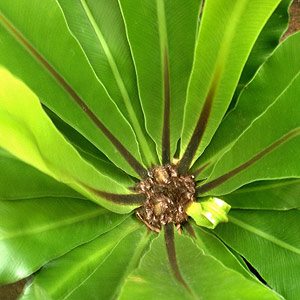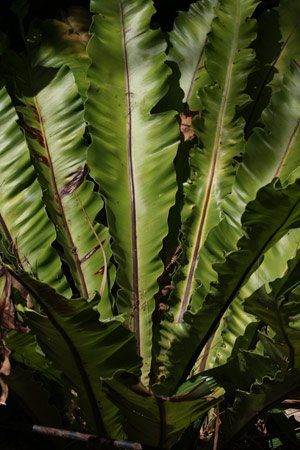
One of the outstanding ferns for the garden is the Bird’s Nest Fern. If you would like to create a tropical or jungle look, these are the plant for you. They come in a number of varieties with different leaf forms. Grow then in the garden or indoors, they are easy care and have fantastic foliage.
With long mid green fronds, these are a fern that forms a rosette of foliage with a centre that tends to collect fallen leaves and looks a little like a birds nest, hence the common name.
This is an epiphytic fern by nature however it does grow well both in the ground and in containers as well as a mounted specimen.
These are a fern that grow in low light conditions, Native to the rainforest areas of New South Wales and Queensland. The Bird’s Nest fern makes an excellent specimen in a shaded position in the garden or in a fernery.
Grow them in containers as an indoor plant or on on a shaded patio the broad green foliage radiates out in a circular fashion. The plant grows well in protected areas as far south as Melbourne.
They also make excellent feature plants in the garden in a shaded rockery or beneath large trees. The large bold foliage makes this an excellent structural plant and a mature clump can be dramatic addition to the garden.
Plants can reach a large size with individual fronds reaching over 1m in length. And yes it does look a little like a nest from above.

Care and Growing Conditions
A humus rich, moist but well drained soil is best, dig in lots of organic matter before planting. Wet clay soils are not suitable.
How to Grow Bird’s Nest Fern
Remember that these are an epiphytic fern, they like good moisture as well ad good drainage.
They are also shade loving, planting then in dappled shade to light shade is best, direct sun can result in leaf burn fairly quickly.
Fertilize with a liquid seaweed fertilizer in spring and again in late summer. A slow release type in spring could also be used. Plants should be kept moist.
Pruning is not really required although the fussy gardener may wish to remove old dead fronds for the sake of appearance.
Make sure you provide appropriate shade if growing outside, shade cloth, a south facing position and filtered rather than direct sun light.
If you are considering transplanting a Birds Nest fern, you will need to take a large rootball, so be prepared for a little digging.
Problems
- Brown leaf tip and edges usually mean a lack of water, try not to let the soil dry out for long periods.
- Yellow leaves can be caused by natural ageing, to much heat, of to much cold
- Brown spots on the leaves – Usually these are the spores of the plant, this is normal. Check to make sure the spots are not actually scale insects.
Available for sale from the following nurseries
601 Sunnyholt Road Parklea NSW 2768
Parklea Pots and Plants are affordable, open 7 days and have everything you need for your garden - of any size!. Pots, plants, water features, fruit trees, hedging, potting mix and more.
Opening hours 7 days a week from 8:30am to 5pm
www.potsandplants.com.au
Bird’s Nest Fern Varieties
- Asplenium nidus – This is a tropical species, growing from Northern Queensland through to New Guinea. In cooler climates, even temperate areas it requires a greenhouse.
- Asplenium nidus ‘Osaka’
- Asplenium antiquum Lady Victoria
- Asplenium ‘Lasagne

